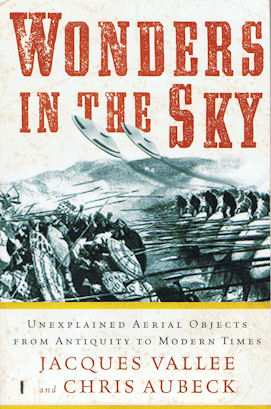





by Jacques Vallee and Chris Aubeck

Reviewed by Theresa Welsh
|
REVISITING MAGONIA — A New Compilation of Unexplained Aerial Events Jacques Vallee is well known for his unique viewpoint on the phenomenon known as UFOs, beginning with his groundbreaking book, Passport to Magonia, published in 1969. "Magonia" reviewed odd events from mythology, religion and folklore that resemble modern UFO sightings, visitations and abductions. In Wonders in the Sky, Vallee teems up with Chris Aubeck to again examine unexplained objects as reported in literature going back to BC and forward to 1890. The objective was to scour every available source and review each instance and eliminate those which cannot be traced to an original reliable source or which have a possible natural explanation, leaving a list of 500 historical sightings, which are truly unexplained. Using Modern Means of ResearchSuch a review is possible because of the Internet, which makes available many old documents, records and books for perusal by scholars and researchers. Vallee and Aubeck selected what they regard as the most credible sightings from a much larger pool. At first, I was a bit disappointed to see the book is mainly a list of mostly small paragraphs describing an item, with date, place and source, arranged by century. But once I started reading, I found the descriptions fascinating and could begin to see some patterns in the listings, which come from all over the world, but with preponderance from the UK. The authors confined themselves to mainly objects (some just balls of fire or lights) in the sky, with a smaller number of listings that include entities. It becomes clear as you read that people see things consistent with their cultural environment including how they interpret entities. During some periods, the entities are angels or messengers from God, other times they are fairies and "little people" and at other times they are devils and demons. In our own times, they are aliens from other planets, but this book does not cover the so-called modern UFO era dating from Kenneth Arnold's sighting of flying saucers in 1947. Seeing the Phenomenon Through Many Cultural ContextsThe objects too have various descriptions. The Chinese describe most aerial phenomena as "dragons." Prior to the 18th century, objects were often described as ships sailing through the air. Witnesses describe ships consistent with their era and often with people on them. In ancient times, witnesses saw armies fighting each other in the sky. The "fighting armies" descriptions are especially puzzling. Did they really see people with swords and shields up in the air, or were these weather phenomena that looked like armies? Speaking of shields, in historical times, witnesses often said the objects were "flying shields." In all times, witnesses describe both the appearance and the duration of the sighting in terms of their every day experiences. For instance, a sighting lasted as long as it takes to "say two Te Deums" or the time to sing "six sharakans" or the object was the color of "heated iron" or it looked "like a big man's hat." Their comparisons are often to things we today do not use or know anything about. Is "shield" a similar description to "saucer?" Is a "flying hat" similar to a "flying pyramid?" Taking "Unexplained" SeriouslyThe authors make clear their opposition to the standard reply of scientists that all aerial phenomena can be explained in a rational way as natural events. In the Introduction, Vallee takes a poke at Stephen Hawking, who has expressed his disdain for UFO research and has asked why UFOs only appear to "cranks and weirdoes." Vallee refutes this with evidence that many sightings are from very reliable witnesses, often pilots and military people, and further, that these unexplained events have actually played a major role in the history of humanity. Clearly, he feels the scientific community is only displaying arrogance in ignoring this phenomenon. The conclusion to the book states that "…the so-called 'rational' explanations proposed by academic experts are often as delusionary as the most fanciful reports, and they fail to account for the observed facts in the same way." However, Vallee himself is careful to keep separate his two big interests: his role in computer networking history and his role as a UFO researcher. He is currently a Silicon Valley investment capitalist and in that role, he does not promote his UFO books. I have recently read and reviewed his book (which I discovered by chance), The Heart of the Internet, and found it an excellent first-person account of early work at SRI that led to the Internet, and a fascinating other side of the man, Jacques Vallee. He wears both hats very well, but is even he afraid of being thought of as a "nut" for his work on UFOs? A "Previously unknown Physical Element" Wow!The authors do not offer a theory contradicting the usual "aliens from outer space" explanation, but do have a short section at the end of the book that provides some minimal conclusions. The best we get from them in terms of what they think these sightings are is "We suspect that the data we have compiled in our Chronology indicates the presence of a previously unknown physical element." I guess we'll have to content ourselves with that for now. |
|
 |
 |